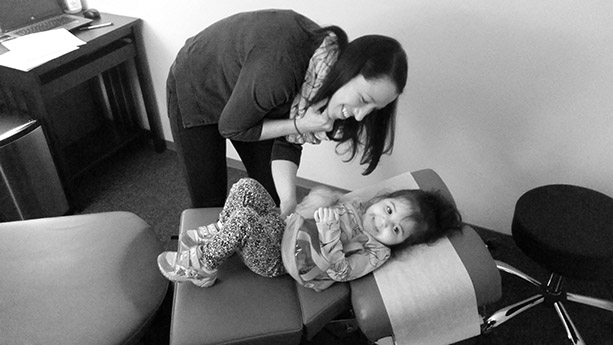Last week, I was adjusting one of our pediatric patients and her mother was telling me how helpful chiropractic has been for her daughter since birth. She expressed concern that many people do not realize how beneficial chiropractic care can be for babies and children. We frequently hear that parents who enjoy chiropractic care themselves still have some concerns about chiropractic for their children. Here are some of the concerns we have heard and a further explanation of each.
“Babies have never had any accidents or injuries, so why do they need to be adjusted?”
Take a moment to visualize the mechanics of childbirth. Even an uncomplicated birth inflicts some trauma on a little body. This can be compounded in cases of prolonged labors, improper positioning, forceps/vacuum/caesarian delivery, etc. While a baby might not have a serious injury, forces are exerted on his/her body in different ways, such as how they are held, put down, or carried. For example, consider the pressure on the back of a baby’s head when the baby has been sleeping on his back all night. The good news is that, unlike adults, babies don’t have long histories or years of dysfunction, bad posture, trauma, or stress; any problems they may have are typically treatable. Infants, on the whole, respond to treatment far faster and more completely than adults do.
“Will a chiropractic adjustment hurt the baby/child? I don’t want my baby ‘cracked’.”
An infant’s skeletal system is underdeveloped, and most of their bones haven’t fully hardened yet. Their skeletons are mostly cartilage, and their joints don’t have the same types of restrictions that adult joints have. They don’t typically “crack,” nor do we try to force them to do so. Adjustments for babies are significantly different than adults. There might be some pressure and massage to specific points, gently moving the baby’s limbs around, and use of the activator tool on the lightest setting to give a light “tap”. Childbirth is traumatic on an infant’s cranium. The skull bones are still shifting and developing, and can be pushed out of alignment during birth or sometime thereafter. To help correct this, we often perform cranial adjustments on babies. This involves extremely light but skillfully directed pressure on the head or face, which is very effective in correcting misalignments. A small infant, as long as they are not already upset for another reason, will usually not mind getting adjusted, and may even be calmed by it.
As babies grow up, the adjustment tends to look more like the doctor or the parent holding the child in their lap while the work is done. If they are accustomed to chiropractic care, particularly if they see their parent lying on the chiropractic table, they are usually willing to do so around age two. As the skeletal system matures, an adjustment on a child can look more and more like what is done for an adult – but always within the comfort level of the child and their parent.
“Toddlers don’t have the same physical stresses on their bodies as adults, so why do they need to be adjusted?”
Toddlers actually have many physical stresses on their bodies. As toddlers become mobile and learn to crawl and then walk, their bodies absorb stress from the movement. Chiropractic care can help keep their gait balanced and normal. The more active toddlers become, the more bumps and falls tend to occur. If you fell down as often as your toddler does, you’d probably need an adjustment too! The good news, again, is that children respond to treatment quite well.
During the school years, stresses on a child’s body start to resemble that of an adult more and more – compounded by more time spent sitting at a desk, carrying backpacks, and sitting at a computer or TV. Chiropractic care can help treat symptoms of the aforementioned behaviors as well as with symptons associated with sports (e.g. injuries, repetitive motions, etc.).
“Will my child will become addicted to/dependent on getting adjusted?”
Children who grow up with chiropractic care can become very attuned to their bodies. This can be a positive thing, as they may be better able to take care of their needs (e.g. for rest, movement, nutrition, etc.) than their peers due to this awareness – it’s a great lifelong skill for them to develop! In addition, they will often be able to feel or notice when they are out of alignment. If they were to discontinue chiropractic care, they would be no worse off than their peers who had never been to the chiropractor. In reality, they are probably still better off from having been in the past. However, children who grow up with chiropractic care will likely notice it more when they feel imbalanced.
“I don’t think chiropractic care can help with my child’s issues.”
Perhaps you would think to take your child to the chiropractor if their neck was stiff or if they were walking funny. What you may not realize is that chiropractic has been shown to help children with many “internal” problems as well, including asthma, ear infections, frequent colds, constipation, and even bed-wetting. Chiropractic care helps improve nervous system functionality, which is important for maintaining homeostasis. While you certainly need to involve your pediatrician in addressing these larger concerns, chiropractic adjustments can be a great adjunct. They have helped many a child avoid the need for another round of antibiotics, ear tubes, laxatives, etc.
If you can think of any further questions or concerns, we would be happy to answer those as well. We hope you’ll consider adding us to your child’s healthcare team.
Sincerely,
Dr. Yori
